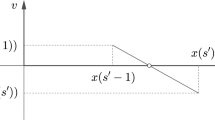Abstract
Kehrein and Kreuzer (J Pure Appl Algebra 205(2):279–295, 2006) presented an algorithm, referred to as the BorderBasis algorithm, for computing border bases. The main objective of this paper is to improve this computation by applying new structures from the theory of Gröbner bases. In doing so, based on the method developed by Gao et al. (Math Comput 85(297):449–465, 2016), a new variant of the BorderBasis algorithm is proposed to compute simultaneously a border basis and also a Gröbner basis for the syzygy module of the input polynomials (this pair of bases will be called a coupled border basis). The new algorithm, and also the original form of the BorderBasis algorithm, have been implemented in the computer algebra systems Maple and ApCoCoA. We compare the performance of our implementation of these algorithms via a set of benchmark polynomials. Our experiments show that our algorithm performs more efficiently than the original BorderBasis algorithm.
Similar content being viewed by others
Notes
By this, we mean that in the division process the leading terms are considered with respect to the coupled term ordering.
References
Auzinger, W., Stetter, H.J.: An elimination algorithm for the computation of all zeros of a system of multivariate polynomial equations. In: Proceedings of International Conference on Numerical mathematics, Singapore 1988, ISNM, International Series of Numerical Mathematics, vol. 86, pp. 11–30 (1988)
Braun, G., Pokutta, S.: A polyhedral characterization of border bases. SIAM J. Discrete Math. 30(1), 239–265 (2016)
Buchberger, B.: Ein Algorithmus zum Auffinden der Basiselemente des Restklassenringes nach einem nulldimensionalen Polynomideal. Dissertations, Univ. Innsbruck, Mathematisches Institut, Innsbruck (1965)
Buchberger, B.: A criterion for detecting unnecessary reductions in the construction of Gröbner-bases. In: Symbolic and Algebraic Computation, EUROSAM’79, International Symposium, Marseille 1979, Lecture Notes in Computer Science, vol. 72, pp. 3–21 (1979)
Buchberger, B.: Bruno Buchberger’s PhD thesis 1965: an algorithm for finding the basis elements of the residue class ring of a zero dimensional polynomial ideal. Translation from the German. J. Symb. Comput. 41(3-4), 475–511 (2006)
Cox, D.A., Little, J., O’Shea, D.: Using Algebraic Geometry, 2nd edn. Springer, New York (2005)
Eder, C., Perry, J.: F5C: a variant of Faugère’s F5 algorithm with reduced Gröbner bases. J. Symb. Comput. 45(12), 1442–1458 (2010)
Faugère, J.C., Gianni, P., Lazard, D., Mora, T.: Efficient computation of zero-dimensional Gröbner bases by change of ordering. J. Symb. Comput. 16(4), 329–344 (1993)
Faugère, J.-C.: A new efficient algorithm for computing Gröbner bases without reduction to zero \((F_5)\). In: Proceedings of the International Symposium on Symbolic and Algebraic Computation, ISSAC’02, Lille, France, 07–10 July 2002, pp. 75–83 (2002)
Gao, S., Guan, Y., Volny, F.: A new incremental algorithm for computing Groebner bases. In: Proceedings of the 35th International Symposium on Symbolic and Algebraic Computation, ISSAC 2010, Munich, Germany, 25–28 July 2010, pp. 13–19. ACM, New York (2010)
Gao, S., Volny, F.I.V., Wang, M.: A new framework for computing Gröbner bases. Math. Comput. 85(297), 449–465 (2016)
Gerdt, V.P.: Involutive algorithms for computing Gröbner bases. In: Computational Commutative and Non-commutative Algebraic Geometry. Proceedings of the NATO Advanced Research Workshop, Chisinau, Republic of Moldova, 6–11 June 2004, pp. 199–225. IOS Press, Amsterdam (2005)
Huang, M.-D.A., Kosters, M., Yang, Y., Yeo, S.L.: On the last fall degree of zero-dimensional Weil descent systems. J. Symb. Comput. 87, 207–226 (2018)
Huibregtse, M.E.: An elementary construction of the multigraded Hilbert scheme of points. Pac. J. Math. 223(2), 269–315 (2006)
Kaspar, S.: Computing border bases without using a term ordering. Beitr. Algebra Geom. 54(1), 211–223 (2013)
Kehrein, A., Kreuzer, M.: Characterizations of border bases. J. Pure Appl. Algebra 196(2–3), 251–270 (2005)
Kehrein, A., Kreuzer, M.: Computing border bases. J. Pure Appl. Algebra 205(2), 279–295 (2006)
Kreuzer, M., Kriegl, M.: Gröbner bases for syzygy modules of border bases. J. Algebra Appl. 13(6), 32 (2014)
Kreuzer, M., Robbiano, L.: Computational Commutative Algebra I. Springer, Berlin (2000)
Kreuzer, M., Robbiano, L.: Computational Commutative Algebra II. Springer, Berlin (2005)
Marinari, M.G., Möller, H.M., Mora, T.: Gröbner bases of ideals given by dual bases. In: Proceedings of ISSAC’91, pp. 55–63. ACM Press, New York (1991)
Mourrain, B.: A new criterion for normal form algorithms. In: Applied Algebra, Algebraic Algorithms and Error Correcting Codes. 13th International Symposium, AAECC-13, Honolulu, HI, USA, 15–19 November 1999. Proceedings, pp. 430–443. Springer, Berlin (1999)
Mourrain, B., Trébuchet, P.: Generalized normal forms and polynomial system solving. In: Proceedings of the 2005 International Symposium on Symbolic and Algebraic Computation, ISSAC’05, Beijing, China, 24–27 July 2005, pp. 253–260. ACM Press, New York (2005)
Mourrain, B., Trébuchet, P.: Stable normal forms for polynomial system solving. Theor. Comput. Sci. 409(2), 229–240 (2008)
Robbiano, L., Abbott, J. (eds.): Approximate Commutative Algebra. Springer, Berlin (2009)
Schreyer, F.-O.: Die Berechnung von Syzygien mit dem verallgemeinerten Weierstraß- schen Divisionssatz. Master’s thesis, Fakultät für Mathematik, Universität Hamburg (1980)
Stetter, H.J.: Numerical Polynomial Algebra. Society for Industrial and Applied Mathematics (SIAM), Philadelphia (2004)
Sun, Y., Wang, D., Ma, X., Zhang, Y.: A signature-based algorithm for computing Gröbner bases in solvable polynomial algebras. In: Proceedings of the 37th International Symposium on Symbolic and Algebraic Computation, ISSAC 2012, Grenoble, France, 22–25 July 2012, pp. 351–358. ACM, New York (2012)
Acknowledgements
The authors would like to thank the anonymous reviewers for their helpful and constructive comments.
Author information
Authors and Affiliations
Corresponding author
Additional information
Publisher's Note
Springer Nature remains neutral with regard to jurisdictional claims in published maps and institutional affiliations.
Rights and permissions
About this article
Cite this article
Hashemi, A., Kreuzer, M. & Pourkhajouei, S. Computing Coupled Border Bases. Math.Comput.Sci. 14, 123–140 (2020). https://doi.org/10.1007/s11786-020-00452-6
Received:
Revised:
Accepted:
Published:
Issue Date:
DOI: https://doi.org/10.1007/s11786-020-00452-6




